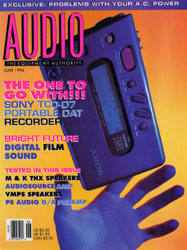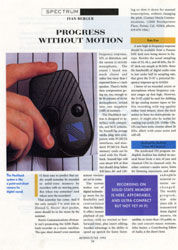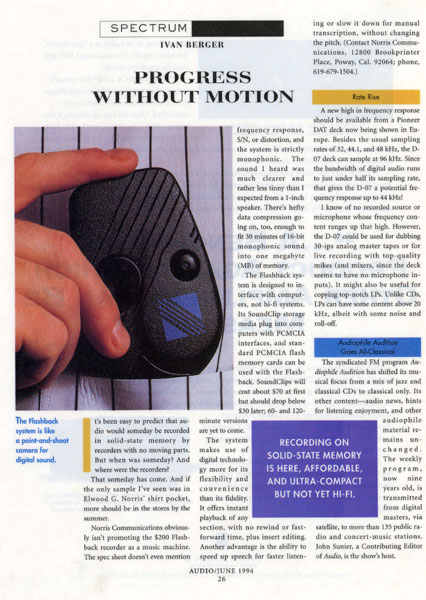

AUDIO
June 1994


PROGRESS WITHOUT MOTION
The Flashback system is like a point-and-shoot camera for digital sound.
Recording on solid-state memory is here, affordable and ultra-compact, but not yet hi-fi.
by Ivan Berger
 |
It's been easy to predict that audio would someday be recorded in solid-state memory by recorders with no moving parts. But when was someday? And where were the recorders? That someday has come. And if the only sample I've seen was in Elwood G. Norris' shirt pocket, more should be in the stores by the summer. Norris Communications obviously isn't promoting the $200 Flashback recorder as a music machine. The spec sheet doesn't even mention frequency response, S/N, or distortion, and the system is strictly monophonic. The sound I heard was much clearer and rather less tinny than I expected from a 1-inch speaker. There's hefty data compression going on, too, enough to fit 30 minutes of 166-bit monophonic sound into one megabyte (MB) of memory. The flashback system is designed to interface with computers, not hi-fi systems. Its SoundClip storage media plug into computers with PCMCIA interfaces, and standard PCMCIA flash memory cards can be used with the Flashback. SoundClips will cost about $70 at first, but should drop below $30 later; 60- and 120-minute versions are yet to come. The system makes use of digital technology more for its flexibility and convenience than its fidelity. It offers instant playback of any section, with no rewind or fast-forward time, plus instant editing. Another advantage is the ability to speed up speech for faster listening or slow it down for manual transcription, without changing the pitch. (Contact Norris Communications, 12800 Brookprinter Place, Poway, Cal. 92064; phone 619-679-1504. |
Contact Webmaster
Copyright © 2001-2005 Woody Norris. All rights
reserved.
Revised: September 29, 2005